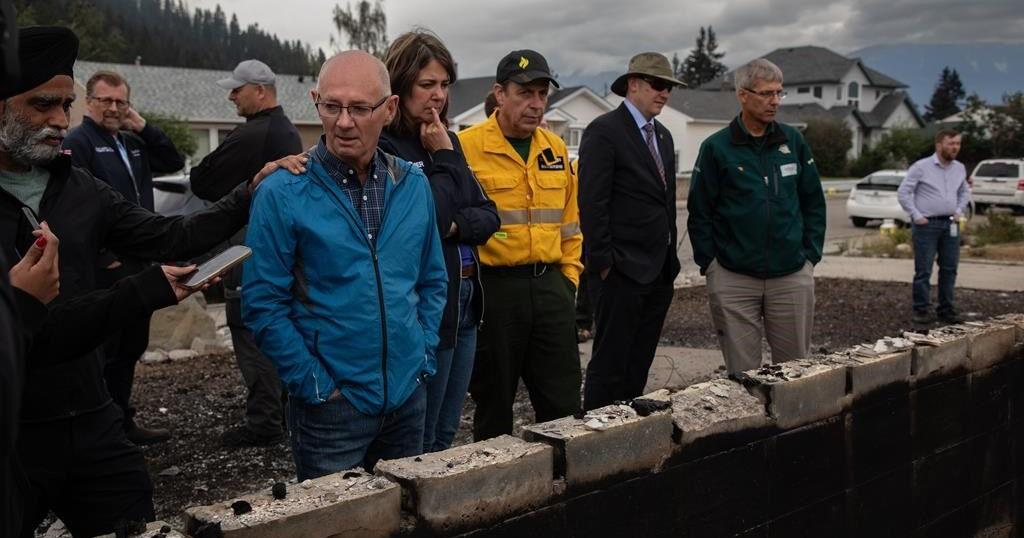JASPER NATIONAL PARK – Richard Ireland’s eyes well up with tears as he gazes in silence towards his home and sees memories of a lifetime burnt to ashes.
The mayor of Jasper then leans over what remains of the small, cosy home he grew up in — a piece of a concrete wall — and says all he can think about is a framed photograph that was taken after his family moved in when he was two years old, lost somewhere in the rubble.
“We grew up here … a family of five kids and our parents, and just about always at least one grandparent was living with us,” the 69-year-old says on Friday during his first visit to where his home once stood in the historic Rocky Mountain resort town before a wildfire burned it down.
“That’s the way life was lived in those days … extended family all under one roof. My home was full of memories,” he says while holding back tears, his lips quivering.
His siblings moved away from his home after and more memories of his own children growing up in the home were formed. He feels sad for the hundreds of photographs of those moments now also burnt to ashes.
But although the ashes of his home lie below his feet, Ireland says he’s glad his garage still stands, with his grandchildren’s toys inside.
“We will rebuild,” he says.
He notes his neighbours’ homes on both sides of his are standing without a scratch, a reflection of how randomly the wildfires destroyed one-third of all structures in Jasper, mostly in the western part of town, or left them grey, ashy, mangled and covered in soot.
During a tour of the town with Ireland, Alberta Premier Danielle Smith and other dignitaries on Friday, the indiscriminate nature of the wildfires could be seen everywhere, with Jasper National Park’s glorious mountain peaks overlooking the devastation.
A trailer park on Cabin Creek Drive in western Jasper has been annihilated, and the disfigured pieces of metal scraps that remain are blanketed in grey ash and black soot.
The burnt skeleton of a bright yellow pickup truck sits nearby with its metallic skid plate melted on the concrete. Heaps of smoke float upwards from the ground in some areas. Shattered glass lies everywhere.
Across the street, however, a row of homes were spared.
Household items, such as chairs, tires, propane tanks and Halloween decorations, could be seen on the sidewalk in front of the homes.
James Eastham, an information officer with Parks Canada who was a part of the tour, says the items are highly flammable and were brought out by firefighters as a preventive measure while Jasper’s approximately 5,000 residents and 20,000 visitors were forced to flee on Monday night as two fires advanced to the town from the north and south.
Jasper’s iconic Maligne Lodge burned down on Wednesday when winds of about 120 kilometres per hour pushed a 100-metre-tall wall of fire into town.
On Friday, a sign for the lodge stood tall while the lodge itself on Connaught Drive was destroyed. Only the skeleton of the rooms’ entrances withstood the flames that firefighters were seen still pouring water over.
Mangled red chairs where tourists once rested were seen in front of the lodge.
Down the street, a Petro-Canada gas station has been obliterated. The silver-coloured steel skeleton of the gas pumps were seen falling over and wooden pieces of the station’s roof were littered across the ground.
Nearby, only a few feet of burnt, brick wall and a tower remained of the Anglican Church of St. Mary and St. George, where residents of Jasper have been gathering since 1928 to pray and attend weddings.
Elsewhere in town, cars were parked on fields of grass, away from flammable homes. Residents abandoned them there before they fled.
Heaps of wood and other unidentifiable, burnt material pushed into a pile by excavators were seen all around town.
After the tour, Ireland told reporters he was feeling hopeful even though 30 per cent of the Jasper townsite had been destroyed.
“That’s important because we have 70 per cent of the base to work from,” he said.
He said he plans to approach the rebuilding of Jasper knowing he’s going through what many other residents are going through after losing their homes.
“Their pain is just unfathomable,” he said. “I feel (their) pain.”
This report by The Canadian Press was first published July 26, 2024.
